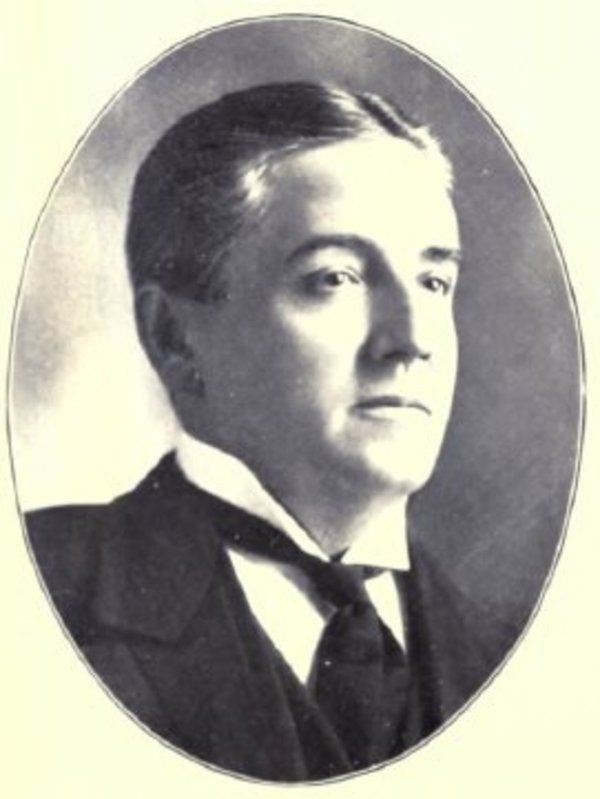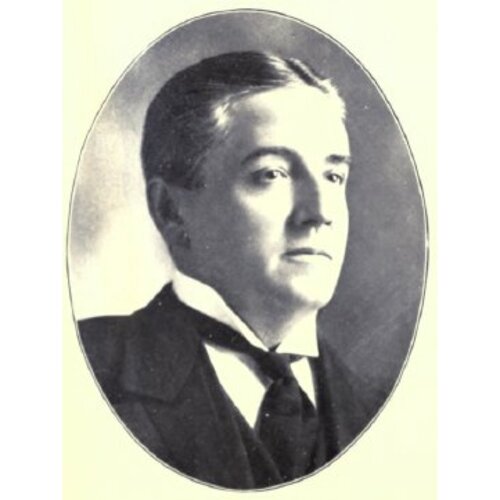
Source: Courtesy of Wikimedia Commons
FULFORD, GEORGE TAYLOR, businessman and politician; b. 8 Aug. 1852 in Brockville, Upper Canada, son of Hiram Fulford and Martha Harris; m. 20 Jan. 1880 Mary Wilder White, and they had two daughters and a son; d. 15 Oct. 1905 in Newton, Mass., and was buried in Brockville.
George Taylor Fulford was the last of five sons of a farming family with uel lineage. Unlike his forebears, he was determined not to be a farmer. After finishing public school and a course in business college, he worked for his brother William M., a dispensing chemist in Brockville. He soon achieved a modest degree of prominence; elected to town council in 1879, he served 12 years as a councillor.
Fulford had a sharp eye for the profitable and in 1887 he moved to tap the thriving market for medicinal products by setting up his own patent-medicine company. Locating his firm in Canada meant that he would benefit from tariffs that protected patent medicines. He experimented with a variety of concoctions but met with little success until he encountered a pill prescribed by a local physician, William Jackson. Fulford purchased the rights to the pill for $100 in 1890 and then launched the Dr Williams Medicine Company, operated by G. T. Fulford and Company, to produce and distribute Pink Pills for Pale People. They quickly became a commercial and advertising sensation and were promoted as a cure for almost everything. Interestingly, Brockville was the Canadian headquarters for another patent-medicine empire, that of William Henry Comstock, originally of New York State, whose most famous product was Dr Morse’s Indian Root Pills.
Fulford’s company flourished in the golden age of patent medicine – the decades before World War I. Social conditions and technological changes were responsible for the boom. The high cost as well as the perceived ineffectiveness of regular physicians made self-medication most attractive to the common person. The invention of machinery capable of manufacturing large numbers of pills and packaging them cheaply provided the basis for huge profits. As well, cheap postage and the growth of the railway system made it possible to ship goods inexpensively over long distances. However, it was the development of mass advertising that made patent medicines so popular. Companies producing them were among the first advertising patrons of the people’s press. Not surprisingly, many newspapers were reluctant to expose the shortcomings of businesses that supplied a large part of their revenue. Fulford’s international advertising budget for Pink Pills in the first decade of the 20th century surpassed a million dollars, according to a brief biography of Fulford written by Arthur Leonard Tunnell and published in 1934.
Fulford was aware of the techniques of “psychological compulsion” and made shrewd use of mass advertising. He hired the owner of the Prescott Telegraph, John A. MacKenzie, to compose promotional materials for newspapers. From almost the beginning he had recourse to a variety of media, from advertisements in the press to leaflets and pamphlets, to get his message across. In time the Dr Williams Medicine Company apparently stopped manufacturing Pink Pills, after it had broken into larger national and international markets, and concentrated on promotion and distribution.
The publication of testimonials from satisfied users of Pink Pills was the principal advertising technique employed by Fulford. Designed to appeal to the average person’s trust in other human beings, they usually provided a gripping, first-hand account of a “miraculous” cure. An early one came from a Hamilton resident who claimed that Pink Pills had cured him of locomotor ataxia, a disorder affecting coordination. Testimonials were customized to fit the locality of business. One produced for the American market in the mid 1890s, for example, drew notice to the health problems of Civil War veterans. When Fulford expanded his enterprise to England, he attracted attention to Pink Pills by offering bicycles as prizes in different areas to those who collected the best testimonials.
The lucrativeness of Pink Pills can only be estimated from the value of Fulford’s empire when he died, which was almost five million dollars. In the early 20th century the pills sold for 50¢ a box or six boxes for $2.50. Tunnell placed the annual consumption in Canada alone at one million boxes, producing, conservatively, more than $160,000 in profits. The high volume of Fulford’s sales demonstrated the fact that patent medicines were big business. The market for Pink Pills extended beyond Canada and North America. By 1905 G. T. Fulford and Company had established branches in Schenectady, N.Y., London, Paris, Sydney, Wellington, Singapore, Bombay, Rio de Janeiro, Buenos Aires, and Cape Town. Branches were later established in China and Hong Kong. Fulford’s nephew, Charles Taylor Fulford, set up a imitative operation in Australia. After Fulford’s death in 1905, the company was run by his partner William T. Hanson of Schenectady until 1929, when George Taylor Fulford Jr took over.
What exactly were Pink Pills? Fulford’s company categorized them as an iron tonic. In an exposé of the patent-medicine industry between 1905 and 1912, the American magazine Collier’s found the pills, which were then touted as a cure for paralysis, to be a “compound of green vitriol [iron sulphate], starch and sugar.” The formula differed from country to country; in Australia, the pills contained iron and arsenic. Obviously there was a great difference between the promises of the advertising and the realities of the ingredients. In 1908 legislation was passed in Canada that forced patent-medicine companies to list the ingredients of their products and tried to restrict their outlandish claims of curing specific diseases. But the problem of misleading advertisements continued for decades.
Patent medicines made Fulford a multimillionaire, and he sought the social status to go with his wealth. He acquired a mansion, Fulford Place, overlooking the St Lawrence River in Brockville, a yacht, corporate directorships, and an automobile. A Liberal, he was appointed to the Senate in 1900 by Sir Wilfrid Laurier*, after he had reputedly donated $5,000 to the Liberal party. “A prince of the patent medicine world,” as he was called by the Toronto World, Fulford died tragically at the age of 53 following a car accident in Massachusetts in October 1905. As a patent-medicine merchandiser and early international Canadian businessman, Fulford had been a leader in the development of techniques of modern mass advertising in a consumer society.
[Information concerning the Fulford family was kindly provided by Hugena Cooke of Brockville, Ont., in telephone interviews with the author of 6 and 7 Oct. 1987. Mrs Cooke was for many years the secretary of George T. Fulford Jr, the senator’s son. p.a.b.]
AO, RG 22, ser.176, 9: 647–50; ser.179, no.3849; Toronto S.C.O. matters, no.106/1906; RG 55, partnership records, Leeds County, declarations, nos.448, 519. NA, MG 26, G: 34439, 57160–62, 67625–26, 90566–67, 90934, 98114–16, 101095–99 (mfm. at AO). Ont., Ministry of Culture and Communications, Heritage branch (Toronto), P. A. Bator, “‘A prince of the patent medicine world’: the career of Senator George Taylor Fulford (1852–1905) of Brockville, Ontario” (research paper prepared for the Hist. resources sect., 1987). Univ. of Toronto Arch., A73-0026/110 (73). Brockville Recorder, 20 Oct. 1905: 5. New York Times, 16 Oct. 1905: 1. Toronto Daily Star, 16 Oct. 1905: 7. World (Toronto), 16 Oct. 1905: 1. S. H. Adams, The great American fraud: articles on the nostrum evil and quackery reprinted from “Collier’s” (5th ed., Chicago, 1912), esp. 53. P. A. Bator with A. J. Rhodes, Within reach of everyone: a history of the University of Toronto School of Hygiene and the Connaught Laboratories (1v. to date, Ottawa, 1990– ). P. S. Campbell, “Nostrum and quack evil,” Public Health Journal (Toronto), 13 (1922): 400–10. CPG, 1905. Adelaide Hechtlinger, The great patent medicine era; or, without benefit of doctor (New York, 1970). Frederick Paul, “The trail of the medical vampire,” Public Health Journal, 9 (1918): 249–54. R. B. Shaw, History of the Comstock patent medicine business and Dr. Morse’s Indian Root Pills (Washington, 1972). Standard dict. of Canadian biog. (Roberts and Tunnell). J. H. Young, The toadstool millionaires; a social history of patent medicines in America before federal regulation (Princeton, N.J., 1961).
Cite This Article
Paul Adolphus Bator, “FULFORD, GEORGE TAYLOR,” in Dictionary of Canadian Biography, vol. 13, University of Toronto/Université Laval, 2003–, accessed April 27, 2025, https://www.biographi.ca/en/bio/fulford_george_taylor_13E.html.
The citation above shows the format for footnotes and endnotes according to the Chicago manual of style (16th edition). Information to be used in other citation formats:
| Permalink: | https://www.biographi.ca/en/bio/fulford_george_taylor_13E.html |
| Author of Article: | Paul Adolphus Bator |
| Title of Article: | FULFORD, GEORGE TAYLOR |
| Publication Name: | Dictionary of Canadian Biography, vol. 13 |
| Publisher: | University of Toronto/Université Laval |
| Year of revision: | 1994 |
| Access Date: | April 27, 2025 |



